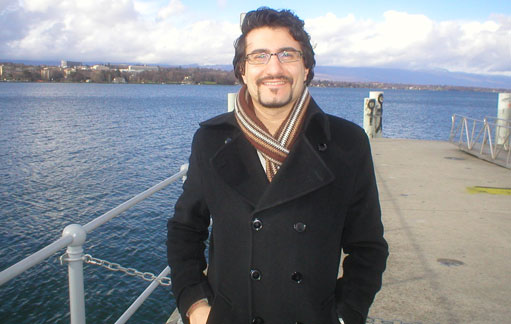Andrea Dotti
25 February 2009 | By

It was Santa Claus who first introduced TileCal data quality coordinator Andrea Dotti to “serious science”, when he was just 12 years old. “Since I was a small kid, I was more skilled in maths,” he explains. “I never liked to learn poems by heart, history was not my thing…” But the year Andrea received a chemistry set for Christmas he was immediately hooked, his interest fostered by a kind elderly pharmacist who sold him supplies.
Soon after, Andrea received a computer, like many of his classmates. But, unlike his peers, Andrea’s machine was not a games console but a PC that was no longer needed at his father’s office. “It wasn’t possible to run any of the games that all my friends had, so it was a little bit annoying – and boring – at the beginning,” he remembers, “but then I started to do other things – small programs that were stupid.” And so began his self-education in computer science. “I was a little bit of a nerd, I think!” he laughs.
If there was ever any truth in that statement, then it’s a thing of the past. Chatting to Andrea, who smiles, “I like to go out, listen to music” it becomes clear that social factors have played almost as big a role in defining his career path as have purely academic choices.
Growing up in Como, in northern Italy, the obvious location for studying physics would have been the nearby University of Milan. But, says Andrea, “I was 18, I wanted to go away from home, and I knew other guys, friends, that were doing physics at Pisa. They pretty much convinced me.”
This was the start of the 10 years that Andrea has so far spent at Pisa. In 2001, while finishing his Masters thesis (on ATLAS’s Tile Calorimeter), he came out to CERN to work on the test beam. Here he had the opportunity to get to know the people working on the calorimeter, and to see the thing itself for the first time. “As a student, maybe you can study it on paper, but to see it and to touch it is completely different. At the beginning it was frightening in a sense,” he remembers, recalling the first Control Room shift he sat. “It seemed like a big responsibility because you had to stay there and press buttons to control the beam,” he explains.
He soon went on to join Pisa’s ATLAS group as a PhD student, and admits, “I am in ATLAS basically for personal reasons, in the sense that the group was extremely good, and I immediately found myself working well with them.” The group – a small one at around 10 members – were very close, and spent lots of time together both inside and outside of their institute.
Andrea has been based in Geneva full-time, as a Pisa post-doc associate, since April 2008. “I like it, in the end,” he smiles. “’Having CERN and the UN here, it feels bigger than what in reality it is, and the international atmosphere you have in Geneva is great … you have the opportunity to get to know all of the world.”
As TileCal data quality coordinator, Andrea brings together the efforts of the many people who study the data coming off TileCal, and verifies that the calibration system is working. Amongst other things, he designed the real-time display program used in the ATLAS Control Room, which superimposes histograms with pre-defined references. “The power of this is that it can be used while data acquisition is ongoing,” he says, “which allows the experts in the control room to react fast in case of problems. Our goal is to maximise the [amount of good] data that we can acquire during the beam.”
His software played an especially important role on September 10th, as it was one of the indicators of whether ATLAS could see beam or not. “I was there at six a.m. in the control room to check it all for the third time … it was a huge pressure on me because I was worried that we would not be able to run it properly or that it would crash,” says Andrea, recalling his nerves. “But when the beam arrived in ATLAS, we immediately saw everything turning on, all the histograms filling correctly, the event displays showing the splash events … it was a big, big emotion.”
In July 2009, Andrea will move from ATLAS to work on Geant4 – a programme which simulates the interactions of particles in matter, which is used to prepare physics analyses, ready for real data-taking. But he hopes still to be around ATLAS when everything kicks off again in October: “I hope to be able to go into the Control Room, to get a friend to open the door for me,” he smiles, keen to get a look at the first data in order to pursue his other academic interest with Pisa: Looking at jet analyses.
“One of the unique things at CERN is that even though you may not work on something directly, you have the sensation that everybody’s working for the same big project, independently of their department and what they’re physically doing,” he muses, concluding: “It’s not only LHC experiment people waiting for the data – everybody here is waiting for this moment, waiting to understand better.”



